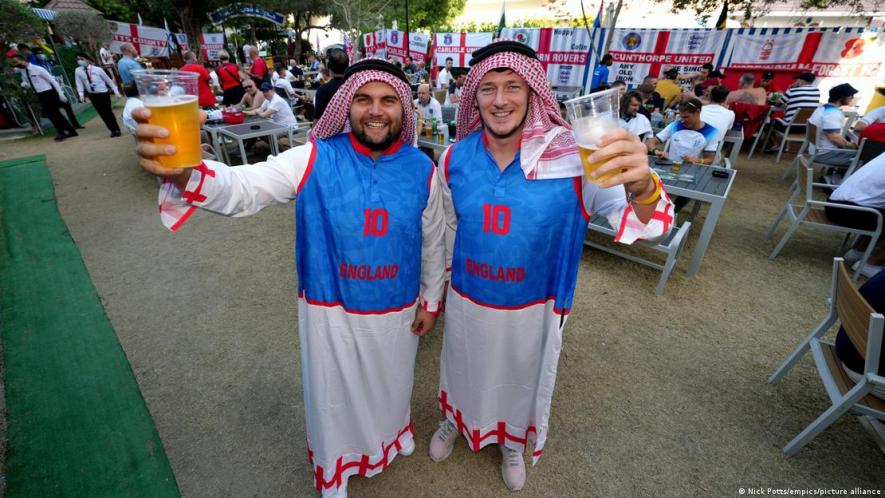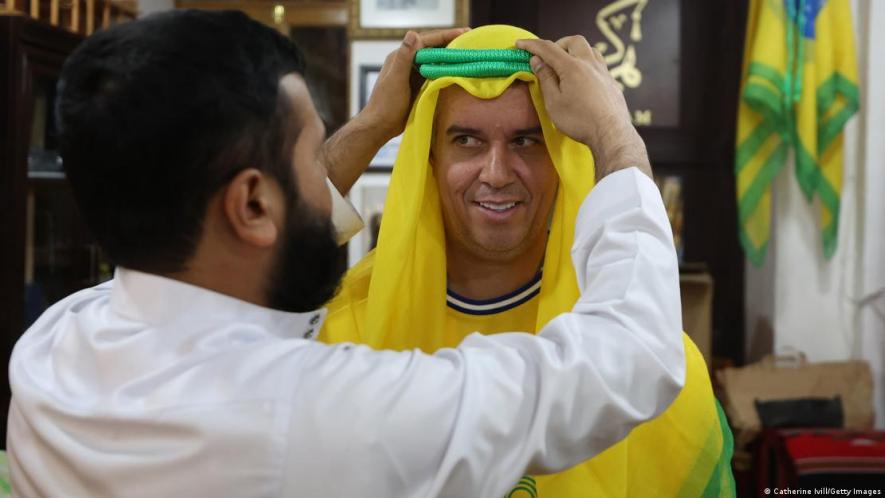World Cup Headwear: Friendly Fun or Cultural Appropriation?

The bustling Souq Waqif in Doha, a recreated market square consisting of old clay buildings, stalls, alleyways and tunnels, has become a social hotspot at the World Cup.
From jewelry to carpets to sandals to painted portraits of the Emir of Qatar to budgies in golden cages — if you want it, you can buy it at the Souq. But one World Cup souvenir is particularly popular: the traditional Qatari headdress, the ghutra.
"It feels great," says Vincent, a Chinese national who studies in the United States, pointing to the white cloth on his head, held together with a black cord and hanging down over his neck. "You can get them everywhere here."
Vincent and his friend have each paid 45 riyals (€12 or $12.50) for their headdresses — and they're not the only visitors adopting the classic attire of the host country, male and female.
'Selling like hotcakes' — particularly to Latin Americans
At the 2022 World Cup, the ghutra is omnipresent, whether framing the red faces of England fans, replacing sombreros on the heads of the Mexicans, or in the form of "La'eeb," the official tournament mascot visible on advertising billboards and screens. Blue-and-white Argentina headscarves are particularly popular, often featuring images of Lionel Messi.
"There's a lot of interest from fans from Latin America," explains Asfundyar from Pakistan, who works at the Ghutra Mundo store, which has six branches across Doha, usually in malls or near underground metro stations.
The bestselling colors are those of Morocco, Saudi Arabia and — perhaps surprisingly — Ecuador, according to Asfundyar. They were temporarily out of stock at the start of the tournament and had to be quickly restocked. "They were selling like hotcakes."

On your head: fans from all over the world, including these England fans, have adopted the ghutra in Qatar
Arab headdresses: Keffiyeh, shemagh or ghutra?
The headdress — under the umbrella term keffiyeh — has long been a traditional hallmark of male attire in the Middle East, from Jordan to Saudi Arabia to the small Gulf states, but it differs from country to country.
The most famous internationally is arguably the black-and-white checkered keffiyeh worn in the 1980s by Yasser Arafat, who later became the first president of the Palestinian National Authority. Through its association with the Palestinian movement, the keffiyeh has taken on a political meaning as a global symbol of revolution and the fight for freedom.
In the Gulf states, however, the red-and-white checkered Saudi shemagh and the all-white Qatari ghutra are unpolitical, still serving the rather practical purpose of protection from the sun and sand storms. In Qatar, the ghutra is generally held in place with a black cord, folded in such a way as to resemble the head of a cobra, and combined with a kandura, a long white shirt which almost reaches the ground.
Tradition born out of practicality
"It's tradition," explains Issa, a Qatari national strolling through the Souq Waqif with two friends in ghutra, kandara and sandals. "The white color protects you against the sun and the heat."
However, while locals will be acutely aware of the small differences in style, tourists sometimes struggle to put it on correctly.
"I've been wearing it pretty much the whole time I've been here," says Mark from Senegal, sporting a ghutra in the Senegalese national colors of green, yellow and red. "Sometimes the Qataris get on to me and come and adjust it for me because it slips."
Social media is dominated by videos showing just such scenes: Foreign fans stood patiently while locals fix their headwear.

Stand still: Many foreign visitors in Qatar have needed help adjusting their ghutras, including this Brazil fan
International understanding or cultural appropriation?
Often, and particularly in Europe and North America, the wearing of the traditional costumes or accessories of other ethnic groups or religions is frowned upon when wearers don't belong to the respective group.
Are World Cup tourists in Qatar being disrespectful by turning a traditional item of clothing into a multicolored fashion accessory? Most fans reject that accusation.
"People from all over the world have come here for the football but also to get to know each other better," says Mark. "That's what the World Cup is all about."
And Issa, like many Qataris, also sees the phenomenon positively.
"It's a good thing; after all, it represents our culture," he says with pride. "We love seeing the fans' different colors."
One color combination, however, hasn't really caught the imagination: black, red and gold. Then again, Germany weren't in Qatar for long and probably didn't have a chance to visit Souq Waqif.
Edited by Matt Ford
Get the latest reports & analysis with people's perspective on Protests, movements & deep analytical videos, discussions of the current affairs in your Telegram app. Subscribe to NewsClick's Telegram channel & get Real-Time updates on stories, as they get published on our website.























